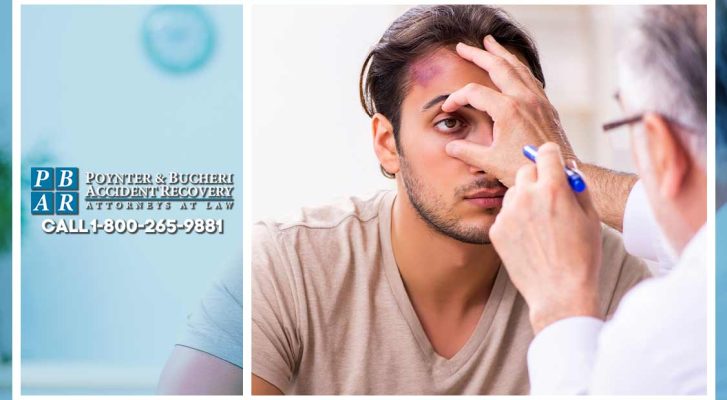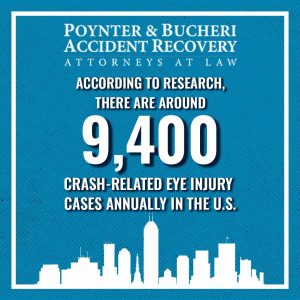
Eye Injury After a Car Accident

Being involved in a car accident can cause extensive injuries, including potentially serious damage to your eyes and vision. From blunt force trauma to penetrating injuries, crashes can pose numerous hazards to ocular health. Understanding common car accident-related eye injuries and what to do if your vision is compromised after a collision is critical.
Prevalence of the Car Accident Eye Injury

Eye injuries are more common in auto accidents than many realize. According to research, there are around 9,400 crash-related eye injury cases annually in the U.S. Some factors that contribute to the frequency of ocular trauma in crashes include:
- Force of impact: Sudden stops exert intense G-forces on occupants.
- Airbag deployment: These can cause abrasions and other damage.
- Broken glass: Fragments can lodge into the eyes.
- Ejections: Increased injuries when occupants are partially or fully ejected.
- Lack of seatbelts: Improper restraint boosts chances of trauma.
With so many potential hazards, examination by an eye doctor after an accident is crucial even if damage isn’t apparent.
Types of Post-Crash Eye Injuries
Some common car accident-related eye injuries include:
- Blunt trauma: Impacts can damage the eyelid, cornea, retina, and the muscles controlling eye movement.
- Hyphema: Bleeding in the front of the eye between the cornea and iris.
- Chemical burns: Car fluid leaks can expose eyes to battery acid, gasoline, and oils.
- Corneal abrasions: Scratches on the surface of the eye’s protective covering.
- Retinal detachment: The retina is pulled away from blood vessels supplying oxygen.
- Foreign objects: Glass, metals, and other debris can penetrate the eye.
- Orbital fractures: Broken eye socket bones caused by forceful contact.
Even minor eye damage should be evaluated as soon as possible before it worsens or threatens vision.
Can You Break Your Eye Socket in a Car Accident?
It is possible to break your eye socket in a car accident. The force generated during a collision can lead to various facial injuries, and the eye socket, also known as the orbital bone, is particularly vulnerable. Orbital fractures, or breaks in the bones surrounding the eye, can occur due to the impact of the collision, especially when there is forceful contact with the airbag, steering wheel, or other parts of the vehicle. These fractures can result in severe pain, bruising, swelling, and potentially affect vision. Prompt medical attention is crucial if an orbital fracture is suspected, as proper diagnosis and treatment are essential to prevent complications and preserve eye function.
Symptoms of a Car Accident Eye Injury
How can you tell if your eyes were hurt in an accident? Symptoms of eye problems after a car accident include:
- Blurry, cloudy, or double vision
- Sharp eye pain or soreness
- Light sensitivity or seeing spots/floaters
- Redness, blood in the eye, or excessive watering
- Bruising around the eyes
- Inability to fully open the eyelid
- Vision loss in all or part of the visual field
Seek medical attention immediately if you experience any concerning eye symptoms following an accident.
Taking Action to Treat and Document Eye Injuries
If you believe your eyes were injured in a crash, critical first steps include:
- 1. Get checked by an ER doctor or eye specialist. Prompt evaluation can prevent permanent loss of vision.
- 2. Follow prescribed treatment plans. This may involve medications, corrective lenses, therapy, or surgery.
- 3. Document your symptoms thoroughly. Keep records of all diagnoses, treatment notes, and health expenses.
- 4. Hire a car accident attorney. They can help recover damages from the at-fault driver’s insurance.
- 5. File a claim or lawsuit before time limits expire. An attorney assists with these deadlines.
Though an eye injury can’t be undone, taking the proper legal and medical steps enables the best possible outcome.
Pursuing Compensation for Car Accident Eye Injuries
Expenses associated with eye trauma treatment, equipment, and potential lost income quickly add up. When another driver’s negligence caused your injury in a crash, their insurance provider should cover these costs. An auto accident injury attorney helps victims:
- 1. Establish fault through a detailed investigation and evidence gathering.
- 2. Calculate both economic and non-economic damages like pain and suffering.
- 3. Negotiate fair settlement offers from insurers.
- 4. Take legal action if needed to recover full compensation.
Expert Guidance from Indiana Car Accident Attorneys
Though monetary damages can’t restore vision, they provide vital resources to help you move forward. Don’t hesitate to consult the experienced car accident attorneys at Poynter & Bucheri. Their experience includes accident injuries of all types, including eye injuries. With proper guidance, you can protect your rights and obtain the maximum compensation available in your case.
If you have blurry vision after a car accident or any other injury, don’t hesitate — an experienced Indiana car accident lawyer can assist you right away. Call 1-800-265-9881 for a free case review.
